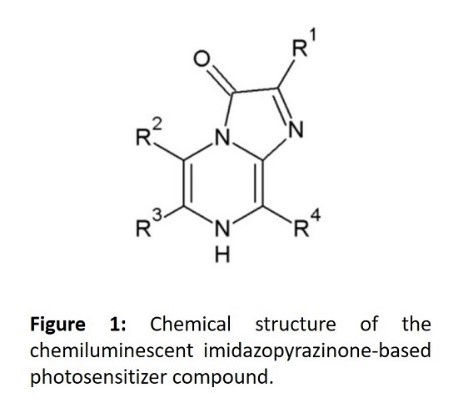
This invention describes the development of chemiluminescent molecules constituted by an imidazopyrazinone core (Figure 1), which are able to readily produce singlet and triplet excited states without the need of an external light source or a catalyst. Electronic structure methods were used to rationalize the chemiluminescent mechanism of the novel molecules. Due to the intracellular and tumor-selective self-excitation, sensitization of cytotoxic species and non-autofluorescence offered by the chemiluminescent reaction, these compounds can be used in cancer photodynamic therapy and/or imaging, as well as a photocatalyst in water-splitting, CO2 reduction, photovoltaics and organic synthesis.
Currently, commercial photosensitizers used in clinical photodynamic therapy require activation by light irradiation by light/laser sources external to the body of the patient. However, typical photosensitizers strongly absorb UV or visible light, which is unsuitable for biological penetration due to light absorption and scattering by tissue. Moreover, the depth of light penetration into the tissues is less than 1 cm. Thus, photodynamic therapy is only used on tumours on or just under the skin or on the outer lining of internal organs/cavities. Moreover, photodynamic therapy is also ineffective against metastatic tumours, given the localized nature of the used excitation sources. If photosensitizers are used that react to wavelength of light from the more penetrative end of the electromagnetic spectrum, such as X-rays or near-infrared, the procedure either becomes very expensive or results in damage to normal tissue. Thus, the use of a photosensitizer that is able to undergo self-excitation intracellularly, without the need for external light sources or any catalyst and co-factor, in a reaction with a cancer marker (overexpressed superoxide anion) has the potential for solving the light-penetration-related problems of photodynamic therapy, while maintaining its tumor-selectivity.
i) Fluorescent molecules with intracellular activity; ii) Simple and straightforward synthesis; iii) Self-excited photosensitizer: no external light sources and no equipment needed; iv) No energy transfer step: production of triplet excited states able to produce ROS; v) Production of optically-active singlet excited states that lead to light emission; vi) Decreased cost and complexity of the therapy; vii) Tumour selectivity: the chemiluminescent reaction is triggered by reaction with superoxide anion, which is overexpressed in cancer cells.
Chemiluminescent photosensitizer for use in: Photodynamic cancer therapy; Cancer theranostics; Photocatalytic Processes.






